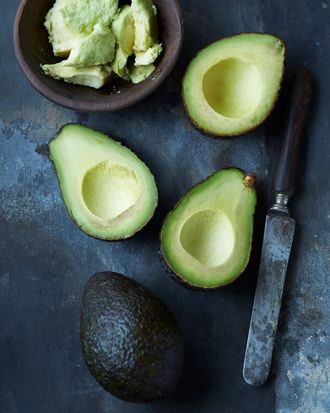
The once-humble avocado has infiltrated every meal: We eat it in omelettes, smoothies, salads, pizza, sandwiches (especially the open-faced Instagram-bait variety), and even ice cream and brownies. If you’re like most people, you’re probably eating more avocado than ever before. According to Grub Street, Americans consumed 1.1 pounds of avocado per capita in 1999, and last year we ate an average of 5.8 pounds each. As you scoop out (or order) that buttery, green goodness with increasing frequency, you might think all that healthy fat means it’s always a healthy choice. But is it? Therein lies the conundrum. What does Google say? Technically, the serving size is one ounce, or one fifth of a medium avocado, but it seems that no sane person follows that. So we asked nutritionists: How much avocado is too much to eat in a day?
It’s important not to think of avocado as a fruit or vegetable: It’s a fat, says Heather Bauer, R.D., C.D.N., founder of bestowed.com, a healthy subscription service. But avocados are mostly monounsaturated fat, which is the healthiest kind, she says. (The American Heart Association says this type of fat could help lower bad cholesterol.) “That being said, calorically speaking, it does accumulate,” Bauer says. “A whole avocado is somewhere between 250 and 280 calories, depending on the size.”
One medium avocado contains about 22 grams of fat (15 of which are monounsaturated) and 10 grams of fiber, which is a very respectable 40 percent of your daily fiber goal (for a 2,000-calorie diet). Both the fat and fiber help you feel satisfied, she says, so all around it’s a great food. But that doesn’t mean you should eat one every day — especially if you’re trying to lose weight.
“What I tell my clients is half an avocado would be sort of the max per day,” says Bauer, who also sits on the nutrition advisory board of Cooking Light. “There are many people out there that struggle with five to ten pounds and they’re eating all the right things, but they’re eating too much of the right things.”
For instance, she says some people might order a virtuous-sounding salad with healthy-fat toppers like salmon, olives, nuts, and avocado, but that salad could end up being 600 to 800 calories. “It’s a tremendous amount of healthy fat in one salad and, calorie-wise, people aren’t burning enough to make up for that,” she says. Bauer recommends choosing one or two fats, like a quarter of an avocado and either a tablespoon of olive oil or three ounces of salmon.
And then there’s the guacamole problem. “A lot of people who eat a whole avocado are doing it via guacamole with chips that have their own fat,” Bauer says. If you need a guacamole fix, she recommends 100-calorie packs from brands like Wholly Guacamole. “Fresh is always best, but when you can’t eat the fresh thing, make sure to have it portioned out.” Instead of chips, she serves it with raw jicama, peppers, cucumbers, or celery with some lime juice and a little salt. And if you’re ordering guacamole at a restaurant, it would be wise not to follow it with a sour-cream-and-cheese-laden entrée; Bauer suggests ceviche and a salad.
But there’s more flexibility for people who have higher total calorie needs, and thereby higher fat needs, says Cynthia Sass, M.P.H., R.D., a sports nutritionist for the New York Yankees and author of Slim Down Now. Sass says she’s fine with her clients who are more physically active eating an entire avocado daily, but acknowledges that doing so would leave less room for other good fats like nuts and seeds or extra-virgin olive oil. “I basically think of it as a budget,” she says. “We each have a certain amount of fat to ‘spend’ daily. If you spend more on avocado you have less to spend elsewhere. Or too much may mean going over budget.” And overdoing it could lead to weight gain over time.
So what is your fat budget? The USDA currently recommends getting no more than 35 percent of your calories from fat, and Sass generally advises 25 to 35 percent, with most of it coming from monounsaturated fats. Moderately active women in their 20s need about 2,000 to 2,200 calories daily, which translates to 56 to 86 grams of fat per day. Women in their 30s and 40s with the same activity level should aim for 56 to 78 grams. Sass says on the top end, that’s about 20 grams of fat per meal if you eat four times a day. And remember that a medium avocado has 22 grams of fat, so it does cut into your total pretty quickly. (Want a more personalized range? Try this energy-needs calculator then multiply your calorie total by 0.25 and 0.35 to determine your fat calories. Next, divide those numbers by 9 for fat grams; fat has 9 calories per gram.)
But some experts argue that these percentages are missing the point. In February, the Dietary Guidelines Advisory Committee, an independent group that provides recommendations to the USDA every 5 years, did not recommend limits on total fat intake for the first time since 1980. “We wanted the emphasis to be on fat quality rather than total fat, because the evidence really emphasizes that saturated fat is the driver of risk rather than total fat intake,” committee chair Barbara Millen said in a release. The committee’s report is with the USDA and the official 2015 dietary guidelines are expected to be released later this year. Whatever happens, you’d be hard-pressed to find a dietitian who says you should be more concerned about your consumption of plant-based fats like avocado than saturated fats like bacon. Guac on.




